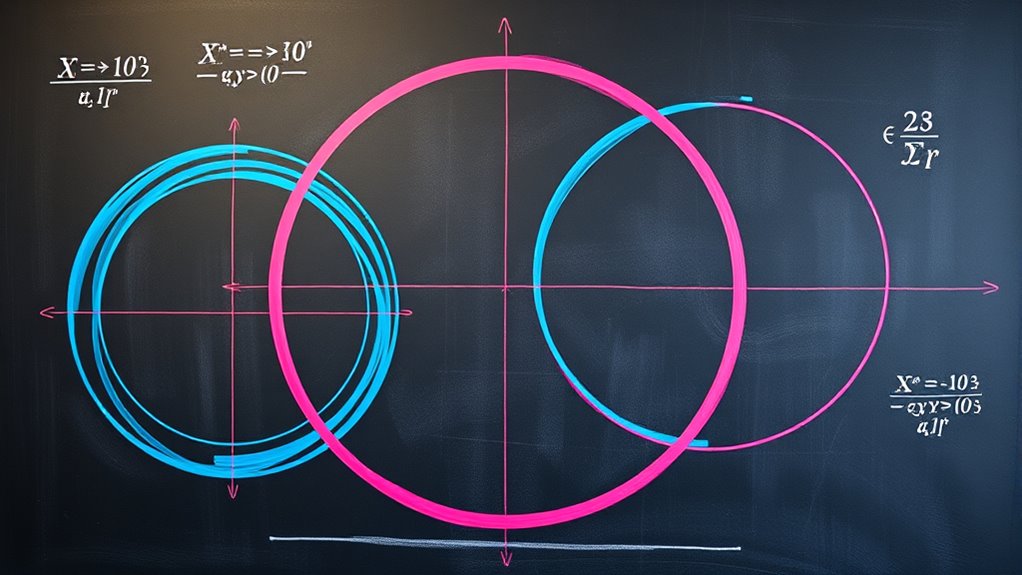In coordinate geometry, the equation of a circle, (x – h)^2 + (y – k)^2 = r^2, describes all points equidistant from a center (h, k). It highlights symmetry, size, and position. By completing the square or using parametric forms, you can find the circle’s center and radius. Understanding these equations helps solve geometry problems involving tangents, intersections, and transformations. Exploring these concepts further reveals more about circle properties and their geometric significance.
Key Takeaways
- The standard form (x – h)^2 + (y – k)^2 = r^2 describes a circle’s center (h, k) and radius r.
- Completing the square helps derive the circle’s center and radius from its general quadratic equation.
- Parametric equations x = h + r cos t and y = k + r sin t illustrate a circle’s symmetry and dynamic properties.
- Tangent lines and intersections are found using derivatives and solving circle equations, revealing geometric relationships.
- Coordinate transformations like translation, rotation, and reflection alter circle positions while preserving core properties.
The Standard Equation of a Circle

The standard equation of a circle describes all the points that are equidistant from a fixed point called the center. This symmetry guarantees that any point on the circle maintains the same distance from the center, highlighting circle symmetry. To find the radius, you can use the equation directly or calculate it from the coordinates of the center and any point on the circle. The equation is written as ((x – h)^2 + (y – k)^2 = r^2), where ((h, k)) is the center, and (r) is the radius. Knowing the radius allows you to understand the size of the circle and perform radius calculations easily. Additionally, understanding the properties of circles can help you analyze and apply these concepts more effectively. This form makes it straightforward to graph, analyze, and understand the circle’s properties in coordinate geometry.
Deriving the Equation From the Center and Radius

To derive the equation of a circle from its center and radius, start by considering any point (x, y) on the circle. The distance from (x, y) to the center (h, k) equals the radius r. Using the distance formula, you get (x – h)² + (y – k)² = r². This equation represents all points equidistant from the center, forming the circle. Tangent lines touch the circle at a single point, creating circle segments that help visualize parts of the circle. By understanding this relationship, you see how the circle’s equation encodes its geometric properties. The derivation emphasizes the link between the circle’s radius, its center, and the set of all points maintaining that fixed distance. Additionally, the contrast ratio plays a vital role in how images appear in different lighting conditions, highlighting the importance of proper calibration for visual accuracy.
The General Equation of a Circle and Its Components

The general equation of a circle helps you understand its shape and position on the coordinate plane. It includes components that directly relate to the circle’s center and radius, giving you key information at a glance. By exploring these parts, you’ll see how the equation describes every circle precisely. Additionally, recognizing the standard form of the equation can simplify the process of graphing and analyzing circles.
Standard Form Explanation
Have you ever wondered how to describe a circle mathematically? The standard form makes it straightforward. It’s written as [(x – h)^2 + (y – k)^2 = r^2], where ((h, k)) is the center, and (r) is the radius. Visualize this with a table:
| Component | Description |
|---|---|
| ((h, k)) | Center of the circle |
| (r) | Distance from center to any point on the circle |
| Equation | Defines the circle’s shape and size |
| Tangent lines | Touch the circle at exactly one point |
| Circle sectors | Portions of the circle divided by radii |
This form emphasizes the importance of the circle’s center and radius, helping you understand tangent lines and circle sectors more intuitively. Additionally, understanding the relationship between the standard form and other circle equations can deepen your comprehension of the circle’s properties.
Center and Radius Significance
Ever wonder why the center and radius are so crucial in understanding a circle’s properties? The center coordinates tell you exactly where the circle is located on the coordinate plane, serving as the focal point from which all points on the circle are equidistant. The radius length determines how big the circle is, defining the distance from the center to any point on its circumference. Together, these elements shape the circle’s size and position. When you see the general equation of a circle, the values associated with the center and radius help you visualize and analyze its geometry. Knowing the center coordinates and radius length allows you to easily identify the circle’s location, size, and how it interacts with other geometric figures. The equation of a circle encapsulates these core components and provides a mathematical foundation for geometric analysis.
Completing the Square to Find the Center and Radius
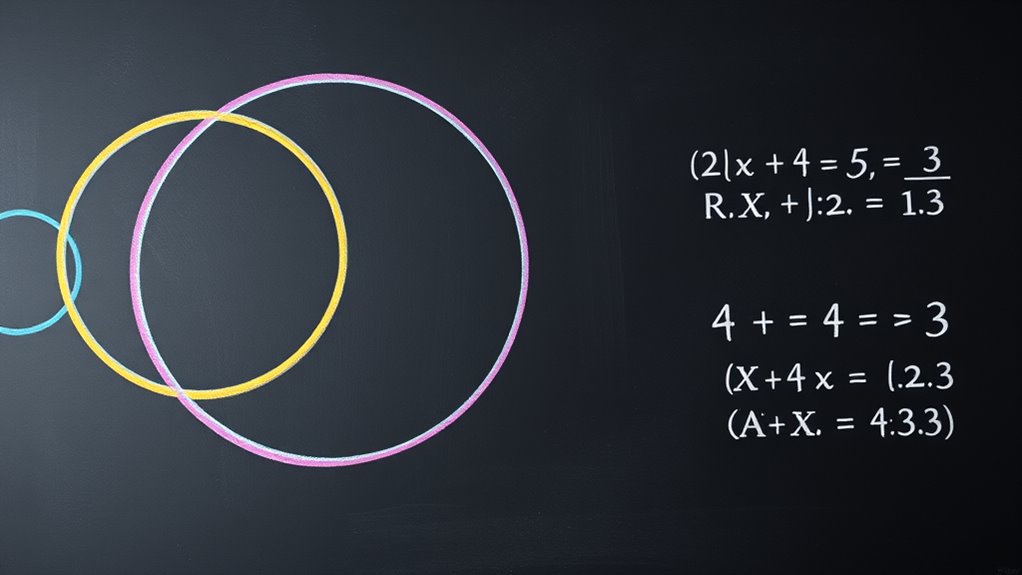
To find the center and radius of a circle from its equation, completing the square is a powerful technique. You start with the general form of a circle’s equation and rearrange terms to group x and y variables. By completing the square for each group, you reveal perfect square trinomials, which makes it easy to identify the circle’s center as the point where the squared terms are centered. This process also simplifies the calculation of the diameter, as the radius is derived from the constant term after completing the square. Recognizing circle symmetry helps you visualize the circle’s shape and confirms your calculations. Overall, completing the square streamlines understanding the circle’s properties and accurately determines its center and radius. Understanding these steps enhances coordinate geometry skills and supports accurate graphing and analysis.
Parametric Equations of a Circle

Parametric equations offer a flexible way to represent a circle by expressing the x and y coordinates as functions of a parameter, usually denoted as t. This approach leverages parametric parametrization, making it easier to analyze and visualize the circle’s properties. Typically, you set the equations as (x = h + r cos t) and (y = k + r sin t), where ((h, k)) is the center and (r) is the radius. These equations highlight the circle’s symmetry about its center, as the sine and cosine functions produce points evenly distributed around the circle. Parametric equations simplify calculations involving rotations and transformations, offering a clear, dynamic view of the circle’s shape and symmetry in the coordinate plane.
Properties of a Circle in the Coordinate Plane
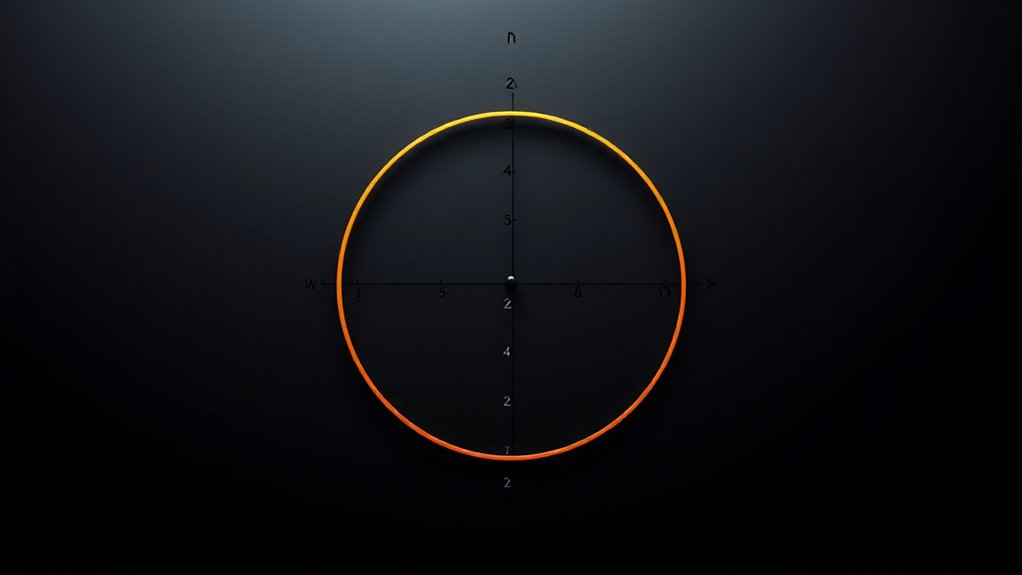
A circle in the coordinate plane has several key properties that define its shape and position. One important property is circle symmetry; it is symmetric about its center, meaning that reflecting the circle across either the x-axis or y-axis through the center results in the same circle. This symmetry helps in understanding the circle’s balance and structure. The radius is a vital measure, representing the distance from the center to any point on the circle. Calculating the radius involves finding the distance between the center and a point on the circle, often using the distance formula. Additionally, the equation of a circle in the coordinate plane provides a algebraic representation that encapsulates these properties. Understanding these properties allows you to analyze and graph circles more effectively, ensuring accurate representations and insights into their geometric nature.
The Relationship Between the Equation and the Graph
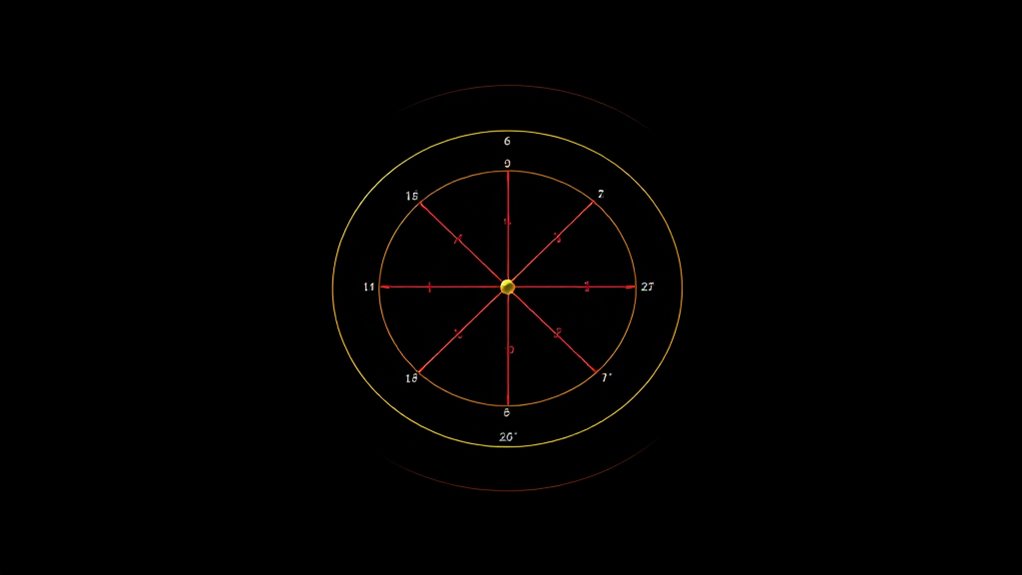
Understanding the standard equation of a circle helps you see how its graph is shaped. The equation reveals the circle’s center and radius directly, making it easier to visualize. By connecting these elements, you can quickly interpret the graph from the equation.
Standard Equation and Graph
Connecting the standard equation of a circle to its graph helps you visualize how algebraic expressions translate into geometric shapes. The equation ((x – h)^2 + (y – k)^2 = r^2) reveals the circle’s center and radius, shaping its graph. To understand this better, consider:
- How the circle’s sectors are formed by the central angles, which relate to the equation’s symmetry.
- How circle tangents touch the graph at exactly one point, illustrating the relationship between the equation and tangent lines.
- How the standard form helps identify features like the circle’s size and position, making it easier to analyze circle tangents and sectors.
- How noise levels of modern heat pumps and their features can influence home comfort and design choices, similar to how understanding the properties of a circle aids in geometric visualization.
This connection makes it easier to visualize and analyze the circle’s properties directly from its equation.
Center and Radius Connection
The standard form of a circle’s equation, (x – h)^2 + (y – k)^2 = r^2, directly reveals the circle’s center at (h, k) and radius r. This connection helps you visualize how the circle is symmetric about its center, maintaining perfect symmetry across both axes. When you draw tangents to the circle, their points of contact align with the circle’s tangent lines, which are perpendicular to radii at the points of tangency. Understanding this relationship allows you to see how the circle’s equation governs its shape and position on the graph. The symmetry of the circle and its tangents reflect the fundamental link between the algebraic equation and the geometric properties, making it easier to analyze and draw accurate representations. Recognizing how the coordinate geometry relates to the circle’s properties enhances your ability to interpret and manipulate these equations effectively.
Identifying the Center and Radius From the Equation

To identify the center and radius of a circle from its equation, start by rewriting the equation in the standard form ((x – h)^2 + (y – k)^2 = r^2). This form reveals the circle’s symmetry around its center (h, k) and makes radius calculation straightforward. Focus on these steps:
- Identify h and k: The numbers inside the parentheses give you the x and y coordinates of the center.
- Determine r: Take the square root of the constant on the right side to find the radius.
- Understand symmetry: Recognizing the circle’s symmetry helps confirm the center’s position and ensures accurate interpretation of the equation.
- To fully grasp Gold IRA investment options, it’s helpful to understand how market trends can impact the value of gold holdings.
Applications of Circle Equations in Geometry Problems
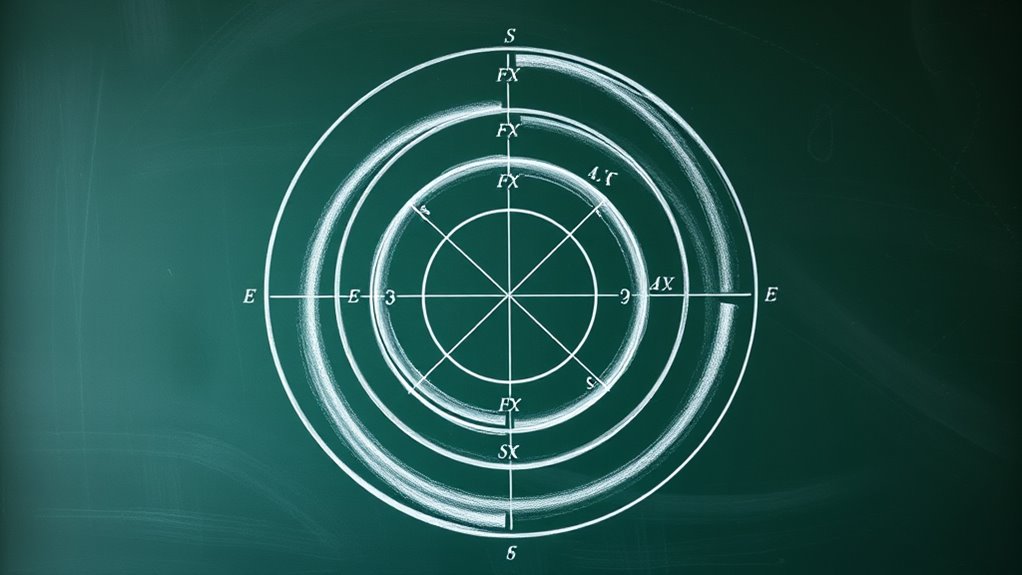
Circle equations are powerful tools in geometry problems because they allow you to find distances, angles, and points of intersection with precision. You can determine tangent lines to circles or find where two circles intersect, which is essential in many problems. For example, identifying circle tangents helps solve problems involving angles and lengths, while analyzing circle intersections reveals common points or solutions. Understanding these applications enhances your problem-solving skills. Here’s a quick reference:
| Application | Description | Example Use |
|---|---|---|
| Circle tangents | Lines tangent to a circle, touching it at one point | Finding the shortest distance from a point to a circle |
| Circle intersections | Points where two circles meet | Locating common points of two circles |
| Geometric constructions | Using circle equations to construct angles or segments | Constructing perpendicular bisectors |
Additionally, understanding the properties of circles can help in constructing tangent lines and solving complex geometric problems efficiently.
Transformations and Equations of Circles

Understanding how circles change under various transformations is key to mastering their equations. Transformations like translations, rotations, and reflections alter a circle’s position while maintaining properties like circle symmetry. To analyze these changes, consider:
- How the circle’s center shifts with translations, affecting the equation’s (h, k) coordinates.
- How rotations around the origin or a point preserve circle symmetry, but change tangent lines.
- How reflections create mirror images, influencing the position of circle tangents and the overall equation.
- Recognizing how image transformations can help visualize these changes and better understand the effects on circle equations.
Frequently Asked Questions
How Do Circle Equations Change in Three-Dimensional Space?
When exploring 3D space, you’ll notice circle equations transform from simple 2D forms to 3D equations involving three variables. These are called 3D circle equations. You can find sphere intersections where circles meet spheres, affecting their equations. To analyze these, you set the equation of a circle in 3D and find where it intersects with a sphere, often leading to new shapes like circles or points, depending on the intersection.
Can Circles Be Represented Using Polar Coordinates?
Yes, you can represent circles using polar coordinates. In polar coordinates, a circle‘s equation often takes the form r = a, where r is the radius and a is a constant, or more complex forms like r = 2a cos θ or r = 2a sin θ. This makes circle representation straightforward, especially for circles centered at the origin or along the axes, simplifying calculations and visualizations in polar systems.
What Is the Significance of the Discriminant in Circle Equations?
The discriminant in circle equations helps you determine the nature of the quadratic form involved. Through discriminant analysis, you can identify whether the quadratic equation represents a real circle, a point, or no circle at all. It indicates if the quadratic form has real, repeated, or complex solutions, helping you analyze the properties of the circle more effectively. Understanding this allows you to classify and interpret circle equations accurately.
How Do Tangent and Secant Lines Relate to Circle Equations?
Tangent lines touch a circle at exactly one point, while secant lines cut through it, intersecting at two points. When working with circle equations, you can identify tangent lines by their single point of contact, often using the condition that the distance from the center equals the radius. Secant lines, on the other hand, intersect the circle at two points, and their equations help find these intersection points.
Are There Special Cases of Circles With Degenerate or Infinite Radii?
Did you know that mathematically, you can have degenerate circles or infinite radius circles? A degenerate circle is fundamentally a point, with zero radius, while an infinite radius circle extends endlessly, resembling a straight line. These special cases occur in limits or certain geometric conditions, but aren’t typical circles you encounter in standard geometry. They highlight how circle concepts can stretch into interesting, sometimes bizarre, forms.
Conclusion
Now, armed with the equations and properties of circles, you’re like a master magician wielding the power to shape the universe’s perfect curves. With a flick of your algebraic wand, you can conjure the center, radius, and endless geometric wonders. These equations aren’t just numbers—they’re the keys to revealing worlds of symmetry and beauty, transforming simple points into majestic circles that dominate the plane like celestial bodies in the vast cosmos.
